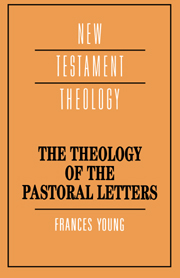Book contents
- Frontmatter
- Contents
- Editor's preface
- List of abbreviations
- 1 Theology and its context
- 2 Theology and ethics
- 3 God and the divine activity
- 4 The importance of sound teaching or What about doctrinal orthodoxy?
- 5 Duties in the household of faith or What about church order?
- 6 The contribution of the Pastorals to the reception of Paul as an Apostle
- 7 The Pastorals as scripture
- Annotated bibliography
- Index of references
- Index of subjects
1 - Theology and its context
Published online by Cambridge University Press: 01 October 2009
- Frontmatter
- Contents
- Editor's preface
- List of abbreviations
- 1 Theology and its context
- 2 Theology and ethics
- 3 God and the divine activity
- 4 The importance of sound teaching or What about doctrinal orthodoxy?
- 5 Duties in the household of faith or What about church order?
- 6 The contribution of the Pastorals to the reception of Paul as an Apostle
- 7 The Pastorals as scripture
- Annotated bibliography
- Index of references
- Index of subjects
Summary
INTRODUCTION
Theology is always earthed in a context. Over the centuries, Christian theologians have tried to construct theological systems which they have believed to be eternal, but in practice the statement of theological truths has to be constantly revised, because human language, human cultures, human philosophies, etc. are all subject to change, and in the end theology has to be articulated for human beings in human concepts.
This is not to pre-judge the issue of the source of revelation. If the Christian claim that God has revealed the divine self has any validity, then God has accommodated that revelation to human circumstances, using human language, coming in human form. One of the key claims of the Christian tradition is that God has been concerned with the particularities of human existence. Christian theology therefore has to take seriously the particular historical context of those documents which are believed to be God's Word, and also the particular context in which those documents are being interpreted.
If that is true for the New Testament in general, it is especially acute for the interpreter of the so-called Pastoral epistles. This title is used for the three little letters which appear to be written by the Apostle Paul to his helpers, Timothy and Titus. However, it seems these letters were slower than others coming into use in the second century, and their contents strongly suggest that to accept that attribution is to misread the setting and purpose of these texts. So there are problems with discerning the particular historical context of these documents. There are also problems for the context of the modern Christian reader.
- Type
- Chapter
- Information
- The Theology of the Pastoral Letters , pp. 1 - 23Publisher: Cambridge University PressPrint publication year: 1994



